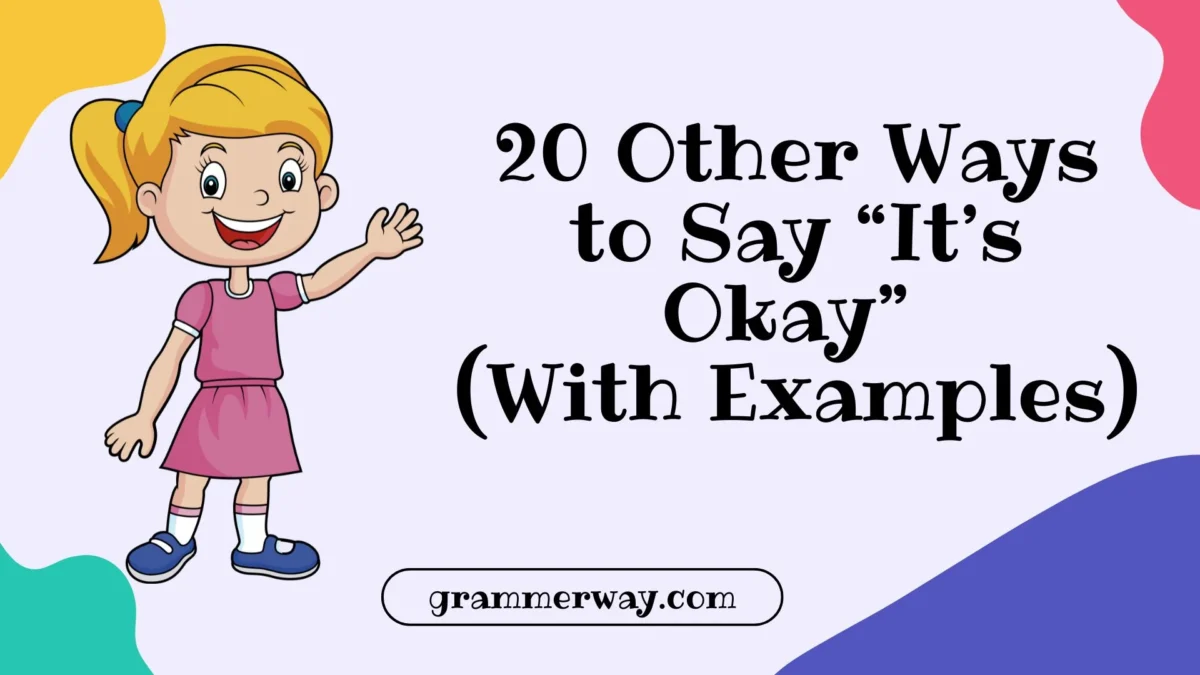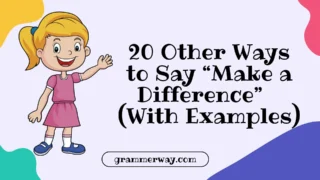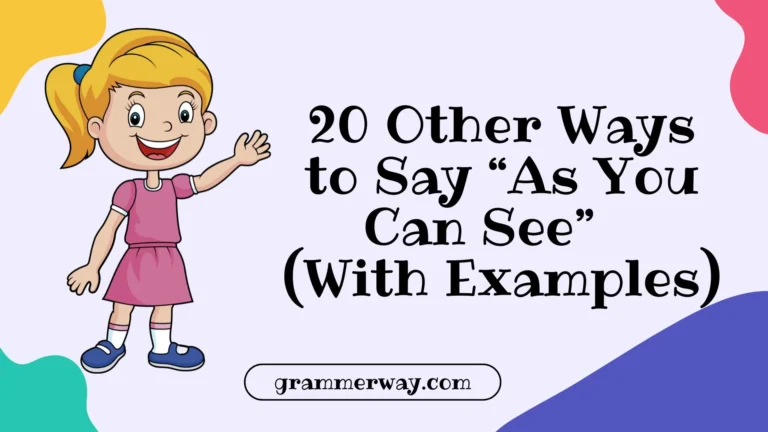We often say “It’s okay” to comfort someone, forgive them, or let them know that everything will be fine. But sometimes, repeating the same phrase can feel a bit plain or distant. Finding other ways to say “It’s okay” can make your message sound warmer, more genuine, and full of care. Whether you’re reassuring a friend, supporting a loved one, or responding professionally, choosing the right words can make your communication feel more personal and meaningful.
What Does “It’s Okay” Mean?
The phrase “It’s okay” is often used to show understanding, acceptance, forgiveness, or reassurance. It can mean that something isn’t a problem, that you forgive someone, or that you’re not upset about a situation. In emotional conversations, it can offer comfort, peace, and understanding. In short, “It’s okay” helps people feel safe and accepted when things go wrong or emotions run high.
Is It Professional or Polite to Say “It’s Okay”?
Yes, “It’s okay” is generally polite and acceptable, but in formal or professional settings, it can sound too casual. In workplaces or written communication, it’s often better to use phrases like “That’s alright,” “No problem,” or “I understand” instead. The key is to match your tone to the context—use warmer alternatives with friends or family, and more neutral ones in professional conversations.
Synonym for “It’s Okay”
- No worries
- Don’t worry about it
- You’re fine
- All good
- It’s all right
- No problem
- Everything’s fine
- You’re okay
- Don’t stress about it
- That’s fine
- It happens
- Not a big deal
- I understand
- We’re good
- Don’t mention it
- Forget about it
- It’s not your fault
- Things happen
- No hard feelings
- It’s totally fine
1. No Worries
Scenario: You can use “No worries” when someone apologizes or feels guilty about something minor.
Meaning: It means there’s no reason to be upset, and you’re completely fine with what happened.
Examples:
- No worries, I totally understand.
- No worries, we can fix it later.
- No worries, everyone makes mistakes.
- No worries, it didn’t bother me at all.
- No worries, I’m glad you told me.
Tone: Friendly, casual, and reassuring.
Explanation: “No worries” is one of the most relaxed and comforting ways to show forgiveness or understanding. It instantly removes tension and lets the other person know everything’s fine between you.
2. Don’t Worry About It
Scenario: When someone feels bad or guilty about a mistake or delay.
Meaning: You’re telling them not to stress or feel responsible—it’s already fine.
Examples:
- Don’t worry about it, it’s no big deal.
- Don’t worry about it, we all forget things sometimes.
- Don’t worry about it, I understand completely.
- Don’t worry about it, we can try again tomorrow.
- Don’t worry about it, everything will work out.
Tone: Comforting, calm, and understanding.
Explanation: This phrase helps relieve guilt and pressure. It shows kindness and emotional support, helping others feel forgiven and safe to move on.
3. You’re Fine
Scenario: Used when someone apologizes or feels embarrassed about something small.
Meaning: It means they haven’t done anything wrong and don’t need to feel bad.
Examples:
- You’re fine, don’t stress.
- You’re fine, really, it’s okay.
- You’re fine, nothing to worry about.
- You’re fine, everyone does that sometimes.
- You’re fine, take your time.
Tone: Reassuring, kind, and casual.
Explanation: Saying “You’re fine” helps someone relax. It’s short, warm, and gives the person comfort that everything’s still good between you.
4. All Good
Scenario: When you want to show that everything is fine and there’s no problem at all.
Meaning: You’re saying no harm was done and things are still positive.
Examples:
- All good, I understand.
- All good, nothing to worry about.
- All good, we’ll figure it out later.
- All good, don’t feel bad.
- All good, mistakes happen.
Tone: Friendly, relaxed, and forgiving.
Explanation: “All good” is casual and comforting. It’s perfect for friends, coworkers, or everyday moments when you want to show easygoing understanding.
5. It’s All Right
Scenario: Used when someone apologizes or is upset about something.
Meaning: You’re letting them know everything is acceptable and there’s no reason to feel bad.
Examples:
- It’s all right, I understand.
- It’s all right, don’t worry so much.
- It’s all right, things happen.
- It’s all right, really, it’s fine.
- It’s all right, I know you tried your best.
Tone: Gentle, patient, and kind.
Explanation: This phrase feels reassuring and soft. It communicates calm understanding and helps the listener feel emotionally supported.
6. No Problem
Scenario: When someone thanks or apologizes for something small.
Meaning: You’re saying it wasn’t a bother at all.
Examples:
- No problem, happy to help.
- No problem, it’s totally fine.
- No problem, don’t mention it.
- No problem, anytime!
- No problem, I get it.
Tone: Polite, relaxed, and professional-friendly.
Explanation: “No problem” works well in both casual and semi-formal settings. It shows that you’re easygoing and not upset by the situation.
7. Everything’s Fine
Scenario: When someone feels anxious or worried that something’s wrong.
Meaning: You’re assuring them there’s no problem and everything is under control.
Examples:
- Everything’s fine, don’t panic.
- Everything’s fine, we’ll handle it.
- Everything’s fine, trust me.
- Everything’s fine, no need to stress.
- Everything’s fine, I promise.
Tone: Soothing, gentle, and caring.
Explanation: “Everything’s fine” calms people down. It’s especially helpful in emotional or stressful situations when you want to bring peace and reassurance.
8. You’re Okay
Scenario: Used to comfort someone who’s upset or embarrassed.
Meaning: It means you accept them and want them to feel at ease.
Examples:
- You’re okay, don’t cry.
- You’re okay, it’s not your fault.
- You’re okay, take a deep breath.
- You’re okay, I’m here with you.
- You’re okay, we’ll fix it together.
Tone: Compassionate, gentle, and emotionally supportive.
Explanation: “You’re okay” provides reassurance and emotional comfort, especially when someone needs empathy more than logic.
9. Don’t Stress About It
Scenario: Used when someone is overthinking or anxious about something small.
Meaning: It means there’s no need to overthink or feel guilty.
Examples:
- Don’t stress about it, it’s really fine.
- Don’t stress about it, we’ll solve it later.
- Don’t stress about it, everyone forgets sometimes.
- Don’t stress about it, it’s all good.
- Don’t stress about it, you did your best.
Tone: Encouraging, calm, and kind.
Explanation: “Don’t stress about it” helps ease tension and shows that you understand the person’s feelings while encouraging them to relax.
10. That’s Fine
Scenario: When you’re approving something or accepting an apology.
Meaning: It means you accept the situation as it is and are not upset.
Examples:
- That’s fine, no worries.
- That’s fine, we can adjust.
- That’s fine, take your time.
- That’s fine, really, don’t worry.
- That’s fine, we’ll do it later.
Tone: Neutral, polite, and understanding.
Explanation: “That’s fine” is a flexible and respectful phrase that works in casual and professional settings when you want to sound calm and understanding.
11. It Happens
Scenario: When someone makes a small mistake or feels bad about something that went wrong.
Meaning: It means mistakes are normal and nothing to feel ashamed about.
Examples:
- It happens, don’t worry too much.
- It happens, we’ll get it right next time.
- It happens, everyone slips up sometimes.
- It happens, you’re doing great overall.
- It happens, that’s just life.
Tone: Kind, understanding, and realistic.
Explanation: “It happens” reminds people that no one is perfect and small errors are part of being human. It’s gentle reassurance that helps people forgive themselves.
12. Not a Big Deal
Scenario: Used when someone overreacts to a mistake or feels bad about something minor.
Meaning: You’re saying the situation isn’t serious or upsetting.
Examples:
- Not a big deal, it’s fine.
- Not a big deal, we’ll fix it later.
- Not a big deal, really, don’t worry.
- Not a big deal, these things happen.
- Not a big deal, I’m not upset.
Tone: Casual, relaxed, and friendly.
Explanation: “Not a big deal” helps lighten the mood and reduce tension. It’s a simple way to let others know you’re not bothered by what happened.
13. I Understand
Scenario: Used when someone apologizes or explains a situation.
Meaning: You’re expressing empathy and emotional understanding toward what the other person feels.
Examples:
- I understand, you had a tough day.
- I understand, no need to explain.
- I understand, things happen sometimes.
- I understand, and it’s all good.
- I understand, take your time.
Tone: Warm, empathetic, and kind.
Explanation: “I understand” shows genuine compassion. It tells the other person that you’re not judging them and that their feelings make sense to you.
14. We’re Good
Scenario: Used when you want to assure someone that everything between you is fine.
Meaning: It means no hard feelings, no anger, and everything’s okay between you.
Examples:
- We’re good, no need to worry.
- We’re good, really, don’t stress.
- We’re good, it’s all behind us now.
- We’re good, I’m not upset anymore.
- We’re good, everything’s fine.
Tone: Friendly, reassuring, and forgiving.
Explanation: “We’re good” helps rebuild trust after misunderstandings. It instantly restores peace and positivity in relationships.
15. Don’t Mention It
Scenario: Used when someone thanks you or apologizes for something small.
Meaning: You’re saying it wasn’t a problem and doesn’t need to be discussed further.
Examples:
- Don’t mention it, happy to help.
- Don’t mention it, I didn’t mind at all.
- Don’t mention it, really, it’s fine.
- Don’t mention it, that’s what friends are for.
- Don’t mention it, it’s not a big deal.
Tone: Polite, kind, and reassuring.
Explanation: “Don’t mention it” shows generosity and humility. It’s often used after helping someone or forgiving a minor mistake, keeping the tone light and warm.
16. Forget About It
Scenario: When you want to show that you’ve moved on and hold no grudges.
Meaning: You’re saying it’s done, forgiven, and not worth worrying about anymore.
Examples:
- Forget about it, I’m not mad.
- Forget about it, it’s over now.
- Forget about it, we’re fine.
- Forget about it, no harm done.
- Forget about it, really, it’s okay.
Tone: Relaxed, forgiving, and friendly.
Explanation: “Forget about it” can sound casual or affectionate depending on tone. It’s great for clearing up awkward situations and showing that everything is truly okay.
17. It’s Not Your Fault
Scenario: When someone feels guilty for something they didn’t cause or couldn’t control.
Meaning: You’re reassuring them that they’re not to blame.
Examples:
- It’s not your fault, don’t blame yourself.
- It’s not your fault, these things happen.
- It’s not your fault, you did what you could.
- It’s not your fault, really.
- It’s not your fault, I promise.
Tone: Compassionate, comforting, and understanding.
Explanation: “It’s not your fault” offers emotional relief. It helps people let go of unnecessary guilt and shows that you understand their struggle.
18. Things Happen
Scenario: Used when life doesn’t go as planned or mistakes occur.
Meaning: It means life is unpredictable and small problems are natural.
Examples:
- Things happen, don’t beat yourself up.
- Things happen, we’ll fix it later.
- Things happen, it’s part of life.
- Things happen, don’t feel bad.
- Things happen, just move on.
Tone: Reassuring, realistic, and light-hearted.
Explanation: “Things happen” helps people accept situations calmly. It reminds them that not everything is within our control — and that’s perfectly fine.
19. No Hard Feelings
Scenario: Used after an argument or disagreement to show peace and forgiveness.
Meaning: It means you’ve let go of negative emotions and hold no resentment.
Examples:
- No hard feelings, I understand your side.
- No hard feelings, we both did our best.
- No hard feelings, let’s move forward.
- No hard feelings, it’s all good now.
- No hard feelings, I still value our friendship.
Tone: Mature, forgiving, and calm.
Explanation: “No hard feelings” restores emotional balance and shows maturity. It’s a beautiful way to close conflicts on a positive note.
20. It’s Totally Fine
Scenario: When you want to sound warm, confident, and caring about a small issue.
Meaning: It means you truly don’t mind and want to reassure the other person.
Examples:
- It’s totally fine, I understand completely.
- It’s totally fine, no harm done.
- It’s totally fine, don’t stress about it.
- It’s totally fine, you’re doing great.
- It’s totally fine, everything’s okay now.
Tone: Friendly, warm, and comforting.
Explanation: “It’s totally fine” is a soft and encouraging phrase that works perfectly when you want to sound emotionally supportive and calm.
Conclusion
Finding other ways to say “It’s okay” helps you sound more thoughtful and kind in every situation. Whether you’re comforting a friend, reassuring a coworker, or forgiving someone, choosing warmer and more meaningful alternatives makes your words feel genuine. Communication isn’t just about words—it’s about the feelings behind them. So next time you want to express care or forgiveness, try one of these heartfelt phrases to make your message truly connect.
FAQs
1. What can I say instead of “It’s okay” in a formal setting?
You can use “I understand,” “That’s alright,” or “No problem.” These sound polite and professional without being too casual.
2. How can I comfort someone without saying “It’s okay”?
Try saying “You’re not alone,” “I understand how you feel,” or “We’ll get through this.” These phrases sound more emotional and supportive.
3. Is it rude to say “It’s okay”?
Not at all — but tone matters. Said gently, it’s kind and comforting; said flatly, it can sound dismissive. Always pair it with empathy.
4. Which phrase works best when forgiving someone?
“We’re good,” “No hard feelings,” or “Forget about it” are all excellent choices for forgiving someone warmly and clearly.
5. How do I express “It’s okay” through text?
Try “All good 😊,” “No worries at all,” or “It happens!” These add a friendly tone and make your message feel light and kind.







Leave a Comment